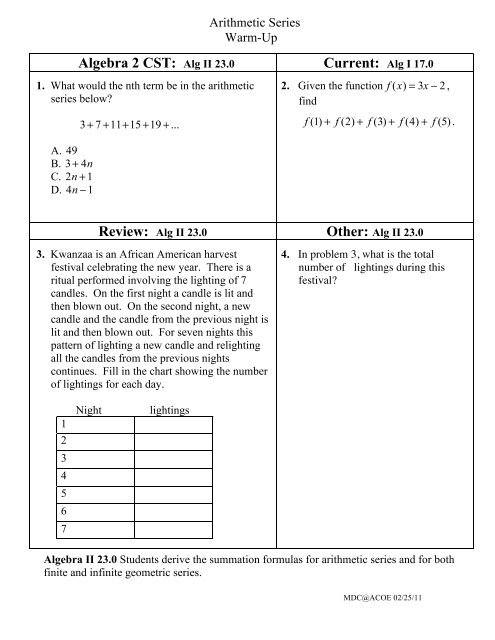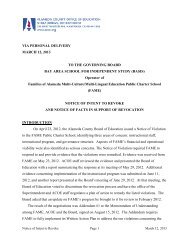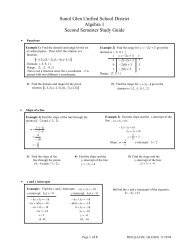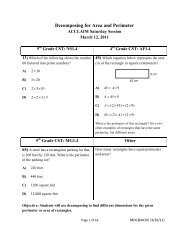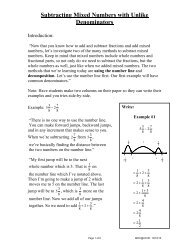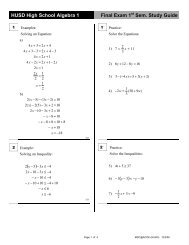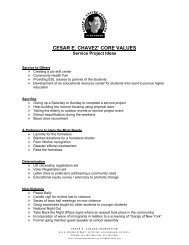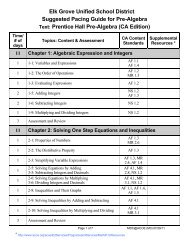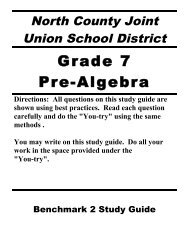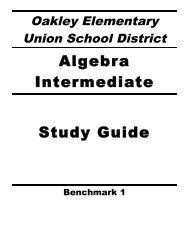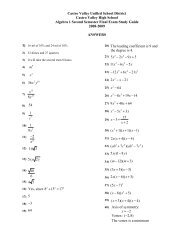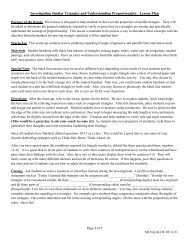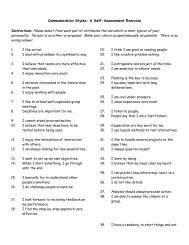Arithmetic Series
Arithmetic Series
Arithmetic Series
You also want an ePaper? Increase the reach of your titles
YUMPU automatically turns print PDFs into web optimized ePapers that Google loves.
<strong>Arithmetic</strong> <strong>Series</strong>Warm-UpAlgebra 2 CST: Alg II 23.0 Current: Alg I 17.01. What would the nth term be in the arithmeticseries below?2. Given the function ,find.A.B.C.D.Review: Alg II 23.0 Other: Alg II 23.03. Kwanzaa is an African American harvestfestival celebrating the new year. There is aritual performed involving the lighting of 7candles. On the first night a candle is lit andthen blown out. On the second night, a newcandle and the candle from the previous night islit and then blown out. For seven nights thispattern of lighting a new candle and relightingall the candles from the previous nightscontinues. Fill in the chart showing the numberof lightings for each day.4. In problem 3, what is the totalnumber of lightings during thisfestival?1234567NightlightingsAlgebra II 23.0 Students derive the summation formulas for arithmetic series and for bothfinite and infinite geometric series.MDC@ACOE 02/25/11
<strong>Arithmetic</strong> <strong>Series</strong>Over-Arching Question:A skydiver who jumps from an airplane falls 16 feet in the first second, 48 feet in the second second,80 feet in the third second, and so on. How many feet would he/she fall in 20 seconds, if air resistanceis ignored?Definition: An arithmetic series is the sum of the terms in an arithmetic sequence.is used to denote the sum of the first n terms in a series.Example 1) Find the sum: .There are 6 terms in this series.Review: How do we know the sequence in example 1 is arithmetic?(It has a common difference of 4)Find the rule for the sequence:Summation Notation, or Sigma Notation, is also used to indicate the sum of terms in a series.Greek letter sigma.is theFor example 1, summation notation could look like this:Add terms 1through 6Rule for thesequenceNotice using the rule for the sequence, we can generate the 6 terms we want to add:So we evaluate as follows:Page 2 of 7 MDC@ACOE 02/25/11
Example 2) Write sigma notation for the sum .The sequence is arithmetic with and .The rule isSigma Notation:We are adding 7termsExample 3) You Try Write sigma notation for the sum .The sequence is arithmetic with and .The rule isSigma Notation:Quick Write: What is the difference between an arithmetic sequence and an arithmetic series?An arithmetic sequence is a sequence of numbers that have a common difference, while an arithmetic seriesis a sum of numbers in an arithmetic sequence.Page 3 of 7 MDC@ACOE 02/25/11
Developing a formula for adding the terms in an arithmetic series:Example 4) Add the first 10 odd integers.One way to write the sum:You can also write this in reverse order:Add the two equations:Simplify:In general, we multiplythe sum of the first andlast terms times n, thendivide by 2.<strong>Arithmetic</strong> <strong>Series</strong> Formula: The sumof the first n terms of an arithmetic sequence isrefers to the last term in the group of numbers we areadding.n is the position of that last term.Example 5) Find the sum of the first 27 terms in the series .To use our formula, we need to know that the sequence is arithmetic. Then we need the first termterm, and the position n of the last term., the lastWe can see that the sequence is arithmetic since there is a common difference of 6.We already know the first term, so .Since we are finding the sum of the first 27 terms, .Since the last term shown is 142, we assume it is in the 27 th position, so =142.Use the formula to find the sum:Page 4 of 7 MDC@ACOE 02/25/11
Example 6) Find the sumMethod 1 Find the terms in the series, then add.Replace k with 3 and then with 4, 5, 6, and 7 tofind the terms.Method 2 Use the series formulaWe can see that we will be adding 5 terms sincethe values of k go from 3 to 7, soUse the rule to find the first term byreplacing k with 3 (the first value indicated for k).We will call this term :Find the last term by replacing k with 7 (the lastvalue indicated for k). We will call this term :Example 7) You Try Find the sum . Use both methods.Find the terms in the series, then add.Method 1 Method 2Using the series formula:a 4= −3( 8) + 2= −22Page 5 of 7 MDC@ACOE 02/25/11
When the last term is unknown:The arithmetic sequence formula can be used to find any term in an arithmetic sequence, so if you don’tknow the last term in the series of numbers you are adding, you can use the arithmetic sequence formula tofind it.Example 8) Find the sum of the first 25 terms in the seriesWe know the sequence is arithmetic with and . We need to find .Use the arithmetic sequence formula:Now use the arithmetic series formula:Example 9) You Try Find the sum of the first 40 terms in the seriesWe know the sequence is arithmetic with and . We need to find .Use the arithmetic sequence formula:Now use the arithmetic series formula:Page 6 of 7 MDC@ACOE 02/25/11
Revisiting the Over-Arching Question:A skydiver who jumps from an airplane falls 16 feet in the first second, 48 feet in the second second,80 feet in the third second, and so on. How many feet would he/she fall in 20 seconds, if air resistanceis ignored?We need to add the first twenty terms of the arithmetic seriesThe skydiver would fall 6400 feet.Page 7 of 7 MDC@ACOE 02/25/11


